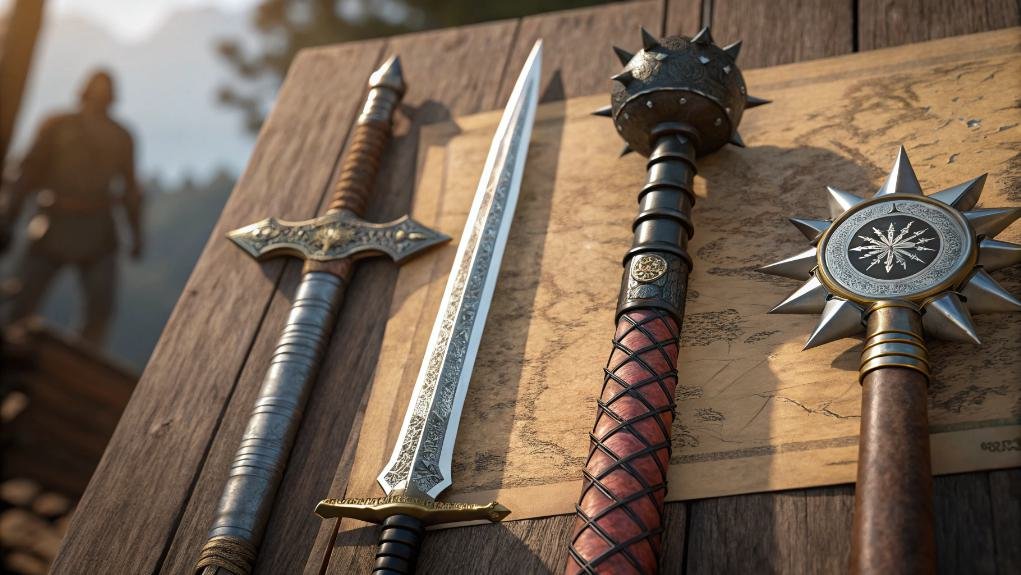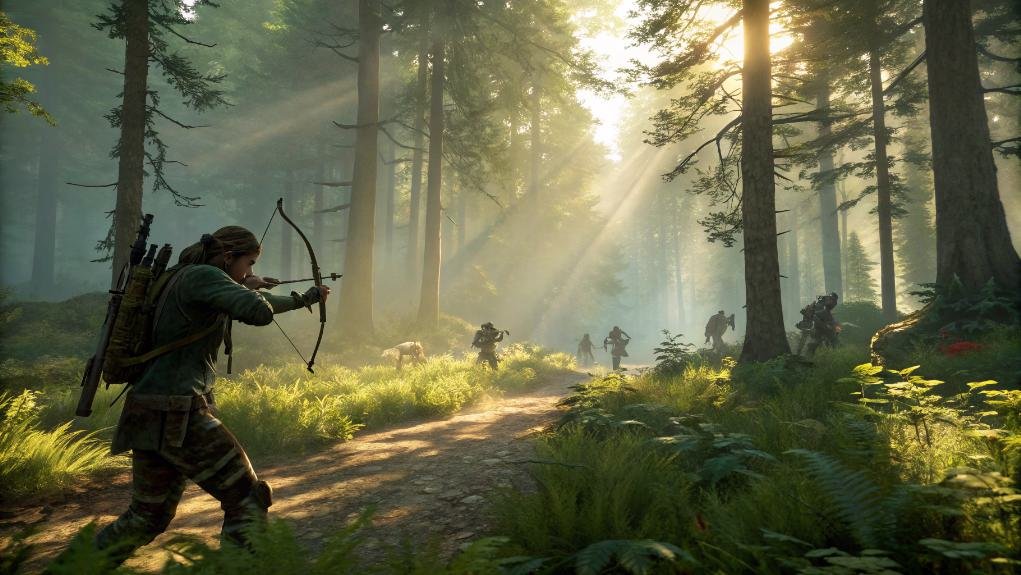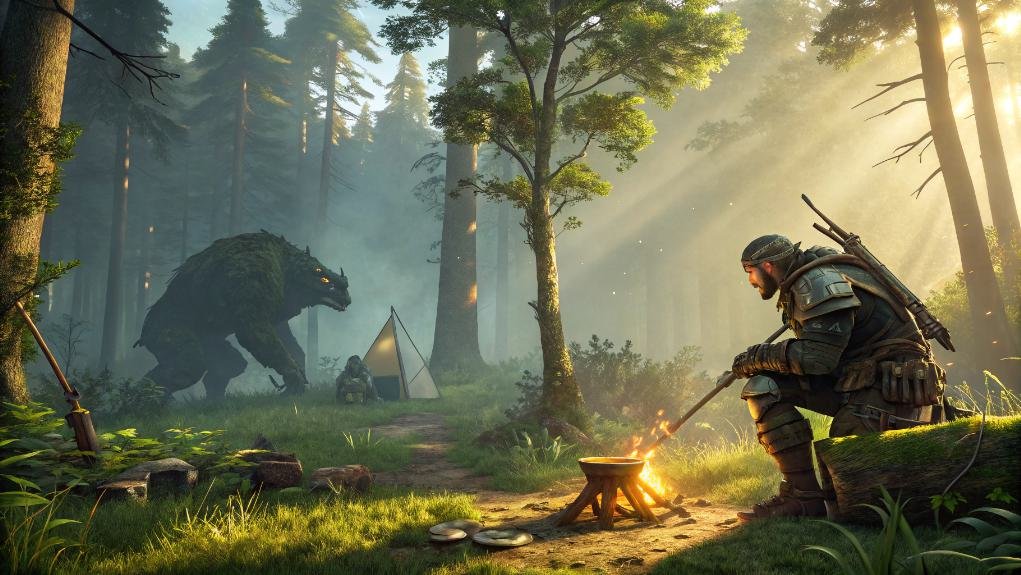In "Monster Hunter Wilds," beginners should master weapon mechanics, like quick swords or powerful great axes, while prioritizing resource gathering. Collect herbs for potions, ore for crafting, and track monster behavior to enhance hunting success. Effective strategies for both solo and team hunts involve understanding patterns and utilizing environmental advantages. Regular gear upgrades keep players prepared for tougher challenges. There's plenty more to explore that can elevate any hunter's experience and tactics for greater victories.
Key Takeaways
- Choose your weapon wisely; swords are fast, while great axes deliver power, affecting your hunting style and strategy.
- Gather essential resources early; collect herbs for health potions, ore for crafting, and bug traps for useful items.
- Learn monster behavior; observe their patterns to predict movements and improve your chances of successful hunts.
- Upgrade your gear regularly; gather materials from specific monsters to enhance weapons and armor for tougher encounters.
- Coordinate with teammates in multiplayer; assign roles like tank or damage dealer for effective team dynamics and increased damage output.
Understanding Weapon Types and Their Mechanics

In Monster Hunter Wilds, understanding weapon types is essential for mastering gameplay. Players encounter a variety of weapon categories, each with unique mechanics.
For instance, swords offer quick attacks, ideal for agile players, but their range may limit effectiveness against larger foes. Conversely, great axes deliver powerful blows, providing significant damage advantages, yet demand precise timing and positioning, showcasing their drawbacks.
Bows and crossbows grant ranged attacks, allowing for safe engagement, but they can struggle in close quarters. Each weapon type complements different playstyles; therefore, players must assess their strengths and weaknesses to optimize their hunting strategies.
Gathering Essentials: What to Collect and Where
What items should players prioritize when venturing into the wilds? Effective gathering strategies can greatly enhance resource management, especially in the early game. Players should focus on collecting essential materials that are vital for crafting and upgrades.
| Item Type | Location | Usage |
|---|---|---|
| Herbs | Forests & Meadows | Health potions |
| Ore | Mountains & Caves | Weapons & armor |
| Bug Traps | Swamps & Trees | Traps & items |
Monster Behavior: Learning Your Prey

Understanding monster behavior is essential for any hunter aiming to survive in the wilds. Each monster has distinct instincts that dictate its actions and reactions. By observing these behaviors, hunters can identify tracking patterns that reveal their prey's habits.
For instance, some monsters may exhibit aggressive responses when threatened, while others might flee or seek shelter when injured. Knowing when to engage or retreat can mean the difference between victory and defeat.
Additionally, understanding the environment can enhance a hunter's ability to predict monster movements. By mastering these elements, hunters can strategically plan their approach, making their hunts more efficient and successful.
In the wilds, knowledge of monster behavior is a hunter's greatest ally.
Crafting and Upgrading Gear for Success
In Monster Hunter Wilds, crafting and upgrading gear is vital for survival and success.
Players need to gather essential crafting materials to enhance their weapons and armor, which directly impacts their effectiveness in hunts.
Understanding upgrade paths can help hunters make informed decisions, ensuring they're always prepared for the challenges ahead.
Essential Crafting Materials
Crafting and upgrading gear is essential for success in Monster Hunter Wilds, and players need to gather important materials to enhance their equipment.
To kickstart their crafting journey, they should focus on collecting basic items like Monster Parts, Herbs, and Iron Ore. These materials can be found in various locations, such as grassy plains and rocky cliffs, making exploration important.
Players can also benefit from crafting tips like tracking down specific monsters for unique parts, which can greatly improve their gear. Additionally, players should keep an eye out for gathering spots marked on the map, as these often yield valuable resources.
Efficiently collecting these important materials will pave the way for a successful hunting experience.
Upgrade Paths Explained
While commencing their hunting adventures, players must navigate various upgrade paths to enhance their gear effectively. Understanding how to gather and utilize upgrade materials is essential for success. Each weapon and piece of armor has specific requirements for crafting and upgrading, so players should familiarize themselves with these needs early on.
Weapon enhancements often involve collecting rare materials from defeated monsters, like scales or claws, which can greatly boost performance. Additionally, players should prioritize upgrading their gear regularly to keep pace with tougher foes.
Effective Strategies for Solo and Multiplayer Hunts

To succeed in both solo and multiplayer hunts in Monster Hunter Wilds, players must adapt their strategies based on the dynamics of their team and the monster they face.
In solo play, hunters should focus on understanding monster patterns and utilizing traps and environmental advantages. Crafting effective hunt tactics around dodging and counter-attacking can make a significant difference.
In multiplayer scenarios, team coordination is essential. Players should communicate roles—like tanking, damage dealing, or support—while guaranteeing they maintain a balance between offense and defense.
Coordinating attacks can stagger monsters, giving the team more opportunities to deal damage. Keeping an eye on each other's health and status effects guarantees that everyone stays in the fight, maximizing overall effectiveness.
Navigating the Map: Key Locations and Resources
Charting the map in Monster Hunter Wilds is vital for success, as knowing essential gathering spots can greatly enhance a player's resource collection.
Additionally, being aware of notable monster habitats helps hunters prepare for encounters and strategize their hunts effectively.
Understanding these key locations will streamline the hunting experience and improve overall gameplay.
Essential Gathering Spots
Understanding where to find essential resources can greatly enhance a player's experience in Monster Hunter Wilds.
By familiarizing themselves with gathering routes and resource hotspots, players can efficiently stock up on important materials.
Here are some prime locations to keep in mind:
- Flintstone Deposits: Commonly found near rocky terrains, perfect for crafting tools.
- Herb Fields: Scattered across various biomes, these areas yield healing herbs and potions.
- Insect Dens: Often located in forested regions, ideal for collecting insect parts.
- Fishing Spots: Rivers and lakes provide fish, a key resource for crafting and sustenance.
Mastering these gathering spots will streamline resource collection, allowing players to focus on their monster hunting adventures.
Notable Monster Habitats
Players looking to hunt effectively must also be aware of where different monsters reside across the diverse landscapes of Monster Hunter Wilds. Understanding habitat diversity is key, as various monsters thrive in specific environments.
For instance, dense forests are home to stealthy predators, while rocky terrains often shelter powerful brutes.
Exploring monster territories reveals unique resources and materials essential for crafting and upgrades. Players should pay attention to environmental cues, like tracks and sounds, which can lead to potential hunting grounds.
Utilizing the map efficiently allows hunters to navigate these regions and maximize their encounters with formidable foes. By familiarizing themselves with notable monster habitats, players can enhance their hunting success and enjoy a richer gameplay experience.

